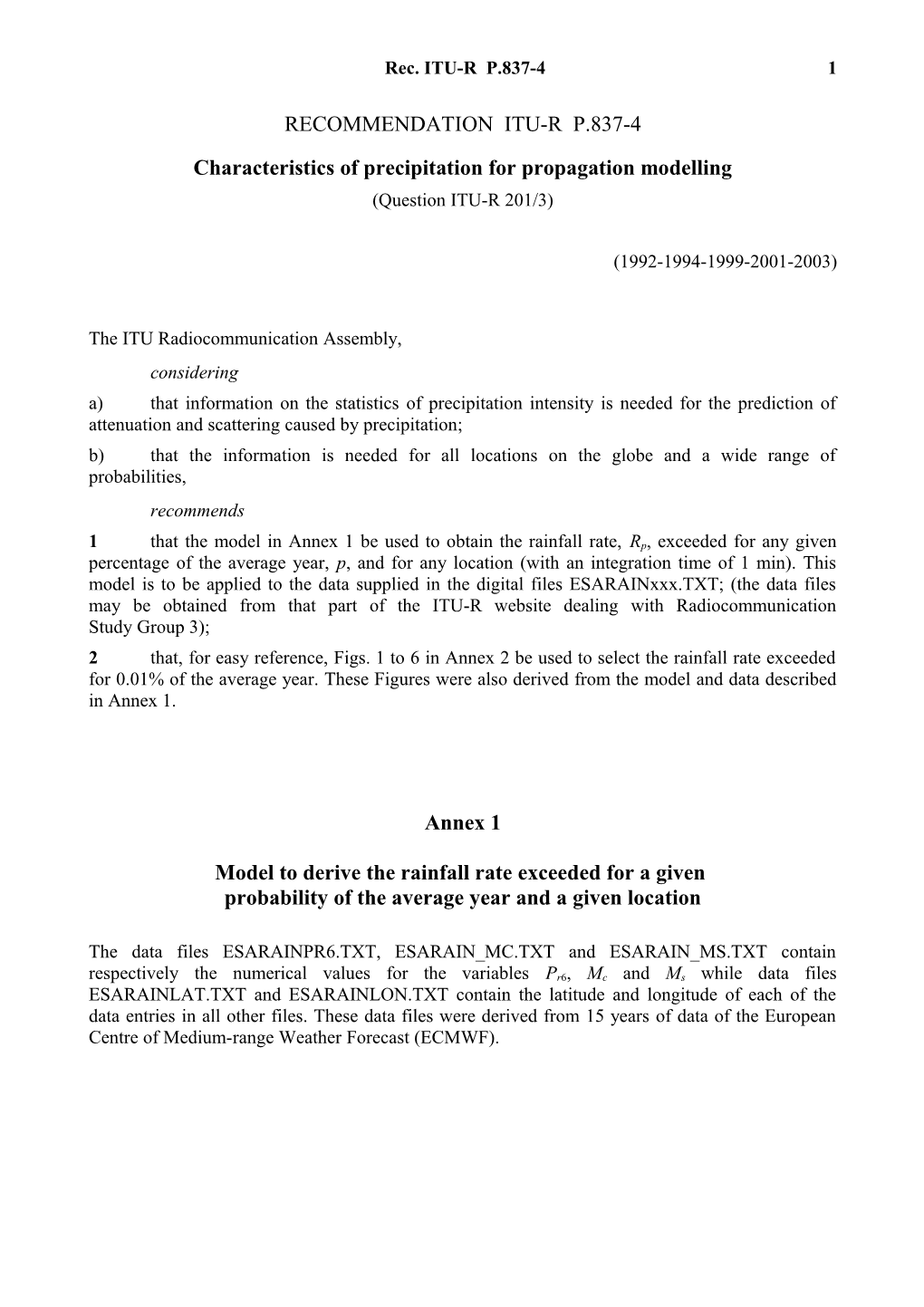Rec. ITU-R P.837-41
RECOMMENDATION ITU-R P.837-4
Characteristics of precipitation for propagation modelling
(Question ITU-R 201/3)
(1992-1994-1999-2001-2003)
The ITU Radiocommunication Assembly,
considering
a)that information on the statistics of precipitation intensity is needed for the prediction of attenuation and scattering caused by precipitation;
b)that the information is needed for all locations on the globe and a wide range of probabilities,
recommends
1that the model in Annex 1 be used to obtain the rainfall rate, Rp, exceeded for any given percentage of the average year, p, and for any location (with an integration time of 1 min). This model is to be applied to the data supplied in the digital files ESARAINxxx.TXT; (the data files may be obtained from that part of the ITU-R website dealing with Radiocommunication StudyGroup 3);
2that, for easy reference, Figs.1 to 6 in Annex 2 be used to select the rainfall rate exceeded for 0.01% of the average year. These Figures were also derived from the model and data described in Annex 1.
Annex 1
Model to derive the rainfall rate exceeded for a given
probability of the average year and a given location
The data files ESARAINPR6.TXT, ESARAIN_MC.TXT and ESARAIN_MS.TXT contain respectively the numerical values for the variables Pr6, Mc and Ms whiledata files ESARAINLAT.TXT and ESARAINLON.TXT contain the latitude and longitude of each of the data entries in all other files. These data files were derived from 15 years of data of the European Centre of Medium-range Weather Forecast (ECMWF).
Step1:Extract the variables Pr6, Mcand Ms for the four points closest in latitude (Lat) and longitude (Lon) to the geographical coordinates of the desired location. The latitude grid is from 90N to –90S in 1.5° steps; the longitude grid is from 0 to 360 in 1.5 steps.
Step2:From the values of Pr6, Mcand Ms at the four grid points obtain the values Pr6(Lat,Lon), Mc(Lat,Lon) and Ms(Lat,Lon) at the desired location by performing a bi-linear interpolation, as described in Recommendation ITU-R P.1144.
Step3:Derive the percentage probability of rain in an average year, P0, from:
(1)
If Pr6 is equal to zero, the percentage probability of rain in an average year and the rainfall rate exceeded for any percentage of an average year are equal to zero. In this case, the following steps are unnecessary.
Step 4:Derive the rainfall rate, Rp, exceeded for p% of the average year, where pP0, from:
(2)
where:
Aab(2a)
Bac ln(p/P0(Lat,Lon))(2b)
Cln(p/P0(Lat,Lon))(2c)
and
a1.11(2d)
b(2e)
c31.5b(2f)
NOTE1–An implementation of this model and the associated data in MATLAB is also available from theITU-R website dealing with Radiocommunication Study Group 3.
Annex 2
Rec. ITU-R P.837-41
